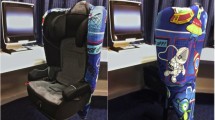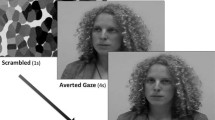Abstract
The effects of another person’s gaze on physiological arousal were investigated by measuring skin conductance responses (SCR). Twelve able children with autism and 12 control children were shown face stimuli with straight gaze (eye contact) or averted gaze on a computer monitor. In children with autism, the responses to straight gaze were stronger than responses to averted gaze, whereas there was no difference in the responses to these gaze conditions in normally developing children. Thus, these results showed that eye gaze elicited differential pattern of SCR in normally developing children and in children with autism. It is possible that the enhanced arousal to eye contact may contribute to the abnormal gaze behaviour frequently reported in the context of autism.


Similar content being viewed by others
References
American Psychiatric Association (1994) Diagnostic and statistical manual of mental disorders (4). Washington DC: Author
Andreassi J. L. (2000). Psychophysiology: Human behavior & physiological response (4). New Jersey: Lawrence Erlbaum Associate
Anstis S. M., Mayhew J. W., Morley T., (1969). The perception of where a face or television “portrait” is looking American Journal of Psychology 82: 474–489
Argyle M., (1975). Body communication. London: Richard Clay Ltd
Baron-Cohen S., Baldwin D. A., Crowson M., (1997) Do children with autism use the speaker’s direction of gaze strategy to crack the code of language? Child Development 68: 48–57
Baron-Cohen S., Campbell R., Karmiloff-Smith A., Grant J., Walker J., (1995) Are children with autism blind to the mentalistic significance of the eyes? British Journal of Developmental Psychology 13: 379–398
Baron-Cohen S., Wheelwright S., Jolliffe T., (1997). Is there “language of the eyes”? Evidence from normal adults, and adults with autism or Asperger syndrome Visual Cognition 4: 311–331
Barry R. J., James A. L., (1988). Coding of stimulus parameters in autistic, retarded, and normal children: Evidence for two-factor theory of autism International Journal of Psychophysiology 6: 136–149
Batki A., Baron-Cohen S., Wheelwright S., Connellan J., Ahluwalia J., (2000). Is there an innate gaze module? Evidence from human neonates Infant Behavior & Development 23: 223–229
Blair R. J. R., (1999). Psychophysiological responsiveness to the distress of others in children with autism Personality and Individual Differences 23: 477–485
Buitelaar J. K., van Engeland H., De Kogel K. H., De Vries H., van Hooff J. A. R. A. M., (1991). Differences in the structure of social behaviour of autistic children and non-autistic retarded controls Journal of Child Psychology and Psychiatry 32: 995–1015
Caron A. J., Caron R., Roberts J., Brooks R., (1997). Infant sensitivity to deviations in dynamic facial-vocal displays: The role of eye regard Developmental Psychology 33: 802–813
Chawarska K., Klin A., Volkmar F., (2003). Automatic attention cueing through eye movement in 2-year-old children with autism Child Development 74: 1108–1122
Clark-Carter D., (1997). Doing quantitative psychological research: From design to report. East Sussex: Psychology Press Ltd
Cline M. G., (1967). The perception of where a person is looking American Journal of Psychology 80: 41–50
Dawson M., Schell A., Fillon D., (1990). The electrodermal system. In: Cacioppo J. T., Tassinary L. G., (Eds.), Principles of psychophysiology New York: Cambridge University Press. pp. 295–324
Detenber B. H., Simons R. F., Bennett G. G., (1998). Roll’em: the effects of picture motion on emotional responses Journal of Broadcasting and Electronic Media 42: 112–126
Donovan W. L., Leavitt L. A., (1980). Physiologic correlates of direct and averted gaze Biological Psychology 10: 189–199
Engeland H. van (1984). The electrodermal orienting response to auditive stimuli in autistic children, normal children, mentally retarded children, and child psychiatric patients Journal of Autism and Developmental Disorders 14: 261–279
Engeland H. van, Roelofs J. W., Verbaten M. N., Slangen J. L., (1991). Abnormal electrodermal reactivity to novel visual stimuli in autistic children Psychiatry Research 38: 27–38
Farroni T., Csibra G., Simion F., Johnson M. H., (2002). Eye contact detection in humans from birth Proceedings of the National Academy of Sciences of the United States of America 99: 9602–9605
Gale A., Spratt G., Chapman A. J., Smallbone A., (1975). EEG correlates of eye contact and interpersonal distance Biological Psychology 3: 237–245
Gibson J. J., Pick A. D., (1963) Perception of another person’s looking behavior American Journal of Psychology 76: 386–394
Hains S. M. J., Muir D. W., (1996). Infant sensitivity to adult eye direction Child Development 67: 1940–1951
Hirstein W., Iversen P., Ramachandran V. S., (2001). Autonomic responses of autistic children to people and objects Proceedings of Royal Society London B 268: 1883–1888
Howard M. A., Cowell P. E., Boucher J., Broks P., Mayes A., Farrant A., Roberts N., (2000). Convergent neuroanatomical and behavioural evidence of an amygdale hypothesis of autism Neuroreport 11: 2931–2935
Hutt C., Ounsted C., (1966). The biological significance of gaze aversion with particular reference to the syndrome of infantile autism Behavioral Science 11: 346–356
Jaffe J., Stern P. N., Perry J. C., (1973). “Conversational” coupling of gaze behavior in prelinguistic human development Journal of Psycholinguistic Research 2: 321–330
James A. L., Barry R. J., (1984). Cardiovascular and electrodermal responses to simple stimuli in autistic, retarded and normal children International Journal of Psychophysiology 1: 179–193
Jonides J., Mack R., (1984). On the cost and benefit of cost and benefit Psychological Bulletin 96: 29–44
Joseph R. M., Tanaka J., (2003). Holistic and part-based face recognition in children with autism Journal of Child Psychology and Psychiatry 44: 529–542
Kanner L., (1943). Autistic disturbances of affective contact Nervous Child 2: 217–250
Kasari C., Sigman M., Yirmiya N., (1993) Focused and social attention of autistic children in interactions with familiar and unfamiliar adults: A comparison of autistic, mentally retarded, and normal childrenDevelopment and Psychopathology 5: 403–414
Kleinke C. L., (1986). Gaze and eye contact: A research review Psychological Bulletin 100: 78–100
Kleinke C. L., Pohlen P. D., (1971). Affective and emotional responses as a function of other person’s gaze and cooperativeness in a two-person game Journal of Personality and Social Psychology 17: 308–313
Klin A., Jones W., Schultz R., Volkmar F., Cohen D., (2002). Visual fixation patterns during viewing of naturalistic social situations as predictors of social competence in individuals with autism Archives of General Psychiatry 59: 809–816
Kylliäinen A., Hietanen J. K., (2004). Attention orienting by another’s gaze direction in children with autism Journal of Child Psychology and Psychiatry 44: 435–444
Leavitt L. A., Donovan W. L., (1979). Perceived infant temperament, locus of control, and maternal physiological response to infant gaze Journal of Research in Personality 13: 267–278
Leekam S., Baron-Cohen S., Perrett D., Milders M., Brown S., (1997). Eye-direction detection: A dissociation between geometric and joint attention skills in autism British Journal of Developmental Psychology 15: 77–95
Lord C., Rutter M., Le Couteur A., (1994). Autism diagnostic interview-revised: A revised version of diagnostic interview for caregivers of individuals with possible pervasive developmental disorders Journal of Autism and Developmental Disorders 24: 659–685
Masame K., (1990). Perception of where a person is looking: Overestimation and underestimation of gaze direction Tohoku Psychologica Folia 49: 33–41
Maurer D., (1985). Infants’ perception of facedness. In: Field T. M., Fox N. A., (Eds.), Social Percepton in infants. New Jersey: Norwood pp. 73–100
McBride G., King M. G., James J. W., (1965). Social proximity effects on galvanic skin responses in adult humans The Journal of Psychology 61: 153–157
Mirenda P. L., Donnellan A. M., Yoder D. E., (1983). Gaze behavior: A new look at an old problem Journal of Autism and Develpomental Disorders 13: 397–409
Nicholas K. A., Champness B. G., (1971). Eye gaze and the GSR Journal of Experimental Social Psychology 7: 623–626
Osterling J., Dawson G., (1994). Early recognition of children with autism: A study of first birthday home videotapes Journal of Autism and Developmental Disorders 24: 247–257
Palkovitz R. J., Wiesenfeld A. R., (1980). Differential autonomic responses of autistic and normal children Journal of Autism and Developmental Disorders 10: 347–361
Pederson J., Livoir-Petersen M. F., Schelde J. T., (1989). An ethological approach to autism: An analysis of visual behaviour and interpersonal contact in a child versus adult interaction Acta Psychiatrica Scandinavica 80: 346–355
Pelphrey K. A., Sasson N. J., Reznick J. S., Paul G., Goldman B. D., Piven J. (2002). Visual scanning of faces in autism Journal of Autism and Developmental Disorders 32: 249–261
Phillips W., Baron-Cohen S., Rutter M., (1992). The role of eye contact in goal detection: Evidence from normal infants and children with autism or mental handicap Development and Psychopathology 4: 375–383
Senju A., Tojo Y., Dairoku H., Hasegawa T., (2004). Reflexive orienting in response to eye gaze and an arrow in children with and without autism Journal of Child Psychology and Psychiatry 44: 445–458
Senju A., Yaguchi K., Tojo Y., Hasegawa T., (2003). Eye contact does not facilitate detection in children with autism Cognition 89: B43–B51
Simons R. F., Detenber B. H., Roedema T. M., Reiss J. E., (1999). Emotion processing in three systems: The medium and the message Psychophysiology 36: 619–627
Stevens S., Gruzelier J., (1984). Electrodermal activity to auditory stimuli in autistic, retarded, and normal children Journal of Autism and Developmental Disorders 14: 245–260
Swettenham J., Baron-Cohen S., Charman T., Cox A., Braid G., Drew A., Rees L., Wheelwright S., (1998). The frequency and distribution of spontaneous attention shifts between social and nonsocial stimuli in autistic, typically developing, and nonautistic developmentally delayed infants Journal of Child Psychology and Psychiatry 39: 747–753
Swettenham J., Condie S., Campbell R., Milne E., Coleman M., (2003). Does the perception of moving eyes trigger reflexive visual orienting in autism? Philosophical Transactions of the Royal Society of London: Biological 358: 325–334
Tan J., Harris P., (1991). Autistic children understand seeing and wanting Development and psychopathology 3: 163–174
Tantam D., Holmes D., Cordess C., (1993). Nonverbal expression in autism of Asperger type Journal of Autism and Developmental Disorders 23: 111–133
Tinbergen N., (1974). Ethology and stress disseasesScience 5: 367–377
Vecera S. P., Johnson M. H., (1995). Gaze detection and the cortical processing of faces: Evidence from infants and adults Visual Cognition 2: 59–87
Volkmar F. R., Mayers L. C., (1990). Gaze behavior in autism Development and Psychopathology 2: 61–69
Wade M. W., Jones R. F., (1982). The accuracy of eye-gaze judgement: A signal detection approach British Journal of Social Psychology 21: 293–299
Willemsen-Swinkles S. H. N., Buitelaar J. K., Weijnen F. G., van Engeland H., (1998). Timing of social gaze behavior in children with a pervasive developmental disorder Journal of Autism and Developmental Disorders 28: 199–210
Acknowledgements
This research was supported by the Finnish Academy (project #50898) and the Finnish Cultural Foundation. We are very grateful to all the parents and children who participated in this research. We would also like to thank Prof. Anthony Bailey and two anonymous referees for their helpful comments.
Author information
Authors and Affiliations
Corresponding author
Rights and permissions
About this article
Cite this article
Kylliäinen, A., Hietanen, J.K. Skin Conductance Responses to Another Person’s Gaze in Children with Autism. J Autism Dev Disord 36, 517–525 (2006). https://doi.org/10.1007/s10803-006-0091-4
Published:
Issue Date:
DOI: https://doi.org/10.1007/s10803-006-0091-4




